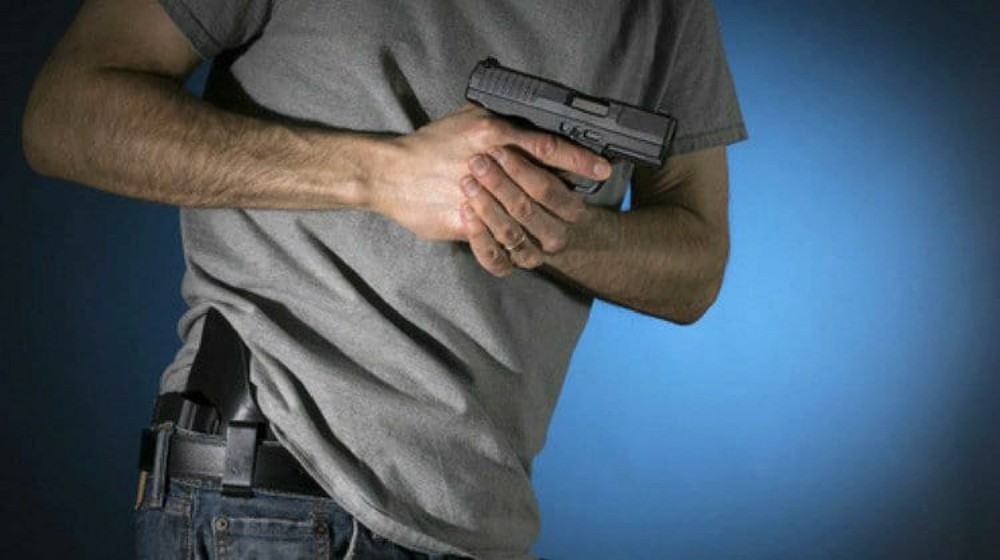Technique & Skills
Weapons Retention During Close Quarters Gun Fighting
Published
1 year agoon

Because a close quarters gunfight is a reality, you need to know how to do weapons retention.
In this article:
- Why You Have to Learn Close Quarters Gun Fighting
- The Benefit of Gun Retention
- Here's What to Do in Close Quarters Fighting
- Learn These Two Vital Skills, Too
Close Quarters Gunfight | A Must-Have Skill for Those Carrying Weapons
Why You Have to Learn Close Quarters Gun Fighting
Why is it important to learn gun fighting in close quarters? Many gun training articles and videos will tell you most shootings occur within 5 to 15 feet max. The police dash or body camera footages showing officers firing in closer distances prove this to be usually true.
Many chaotic events will not give you enough time to line up your sights and gently pull the trigger. In fact, one of the reasons many cops miss their targets in street-combat shootings is they jerk the hell out of their triggers.
They also look over the tops of their guns to see if they are hitting their aim. It is a natural human condition and a hard habit to break.
Cops can have the luxury of time and distance, such as when they're behind a barricade. They can carefully squeeze their rounds within their lined-up sights. They can then hit what they’re aiming at, especially at a longer distance.
Shooting and hitting something much farther away, like 50 to 100 feet, means something different. You must line up your sights. You should also stabilize your shooting posture from behind a barricade or in a Weaver or isosceles stance. It's only then you can squeeze the trigger gently but firmly. To not do any of those three will usually cause you to yank your rounds.
The Benefit of Gun Retention

Many of the close quarters gun fighting videos offer the usual advice. It involves getting the gun out of the holster and focusing on your target quickly. You also need to trust your previous training (we hope) by point-shooting and aiming for the target’s center mass.
One important issue these lessons on gunfighting often miss is the importance of gun retention. You must keep least one hand on your firearm at all times. In and out of your holster, gun retention starts and ends with you. You need to learn to protect your firearm in case a bad guy wants to pull it out of your holster.
Hear me out on this: real crooks practice this stuff. They will learn to disarm other rival bad guys or cops they encounter. If you have a low- to no-retention holster, you should know how to fight back hard enough. The primary goal is to keep the weapon with you.
Some people carrying concealed weapons don’t like high-retention holsters. They feel it will make them slow on the draw. It may somehow hang up and trap their firearm when they need it the most. Both of these are training issues.
Although I own some, I’m leery of using outside-the-waistband holsters without some form of retention. It can be a thumb break or a thumb or finger button release. With inside-the-waistband holsters, you can use your body girth (which I seem to have more of, with each passing year). It will help you keep the weapon trapped against your side.
RELATED: Gun Fight Myths: You Can’t Use Your Sights In Battle
Here's What to Do in Close Quarters Fighting
What do you do when you're in an armed confrontation at close quarters? It can be a few inches or feet apart. You must keep your firearm out of his hands.
It should involve a number of fast-and-furious moves from you. One approach is clamping your hand down over the top of his hand as you quickly pivot away. If you can do this correctly, you can use your body weight to break their elbow. You may even snap their hand off your gun as you shift away.
You should use this same approach as you strike them repeatedly in the face. Use your free hand or forehead. As I always tell my daughter as to why she needs to carry her OC pepper spray, “The fight’s over if he can’t see.” Aim for the bad guy’s eyes with your fingers, fist, or forehead. Blows to the eyes can stop attackers bigger than you.
The key to retaining your weapon is to never lose control of it. If the bad guy gets it out of your holster, it’s probably going to go off. It can be near your head or right by your body. Neither offers positive outcomes.
Keeping your gun in your holster and attached to your belt (which is why I like leather more than Kydex since it’s harder to break) while you pivot, twist, move, and rain blows upon the bad guy’s face offers your best chances for survival.
Learn These Two Vital Skills, Too
You also need to learn two more skills that can affect gun retention and shooting. These are not extending your arms to shoot and being able to shoot one-handed.
The first one is tough to train. You spent so many years or hours at the range firing from eye level. You go from holster to chest height and eye level in one fell swoop. The movement becomes natural and instinctive. It’s how you get to the best firing position when you have the time (and room) to do it.
In a close quarters fight, what you learned may not be the best option. When you extend your gun in a locked-armed position, you encourage the person to knock your arm away. Then they have the chance to grab for your gun.
You must practice shooting with your elbows locked against your sides. Your gun also needs to be at a pointed level from your solar plexus.
Shooting accurately from here means you have to practice positioning the angle. Point your barrel too high, and it will go over his head. Go too low, and you may miss him completely.
Practice shooting with your elbows locked down tight. Your gun must be in front of and below your pectoral muscles. Be careful in range training and during a real fight. Never touch either your semi-auto or your revolver against your body. In a range, it can cause powder burns on your clothes. It may also cause either gun to malfunction.
This video by Active Self Protection is a good example of close quarters combat and gun retention:
In close quarters gun fighting, you may need to use one hand to shoot. The other has to shove away the bad guy or defend yourself from the attack. It means you need to practice shooting one-handed. To succeed in it, you need to feel comfortable shooting with your gun hand and your support hand.
Do you have any advice for a close quarters gunfight? Please let us know in the comments section below.
Up Next: VIDEO: Close Quarters Defense | Frontal Attack
Editor's Note: This article was originally published on August 27, 2017, and has been updated for quality and relevancy.

CZ 75 SP01 Tactical Gun Review | Gun Carrier

PODCAST: Gun Law Changes All Across America Right Now

PODCAST: How to Win Olympic Gold

PODCAST: 50 Important Ideas For Self-Defense, Self-Reliance, and Personal Safety

10 Best Gun Safes In 2022 | Gun Carrier

DP-12 | Double Barrel Pump Shotgun Gun Full Review



Martin Dyer
September 3, 2017 at 9:26 PM
The instructor was not trying to get to his car, he was attempting to get the license plate number of the “crazy person’s” car.